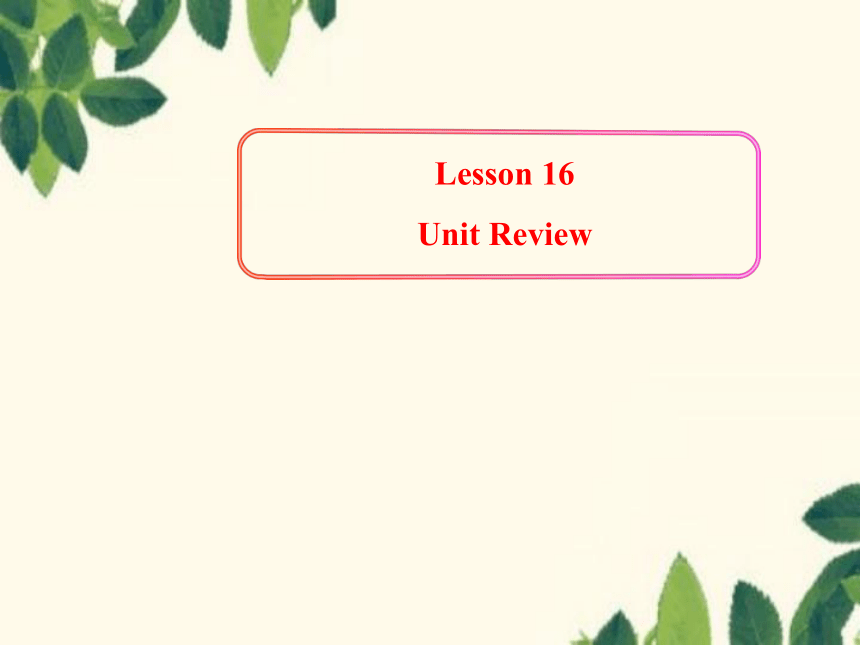(
课件网) Lesson 16 Unit Review 重点短语 be late to do sth. be late for Children’s Day Mother’s Day be short for turn out see sb. doing sth. help sb. with sth. stop doing sth. make sb. do sth. take…to be good at give a talk social studies physical education No noise. some times in two minutes much better not yet half an hour Revision 重点句型 1.—What’s the time —It’s a quarter past three. 2.You don’t need to be good at it. 3.Do we need one. 4.Everyone…except… 5.I’m going to music class. 6.It’s time for … 7.I like …best. 8.I will stop writing now. Ⅰ. 按要求进行词形转换。 hope(adj.) _____ painting(v.) _____ education(v.) _____funny(n.) _____ noise(adj.) _____(adv.) _____ interesting (n.) _____(adj.) _____ hopeful paint educate fun interested interest noisily noisy Ⅱ.将下列短语翻译成英语。 1.上学迟到_____ 2.擅长……_____ 3.帮助某人做某事_____ 4.禁止喧哗_____ 5.关闭(电源)_____ 6.停止做某事_____ 7.是……的简略形式_____ be late for school be good at help sb. with sth. No noise turn out stop doing be short for Ⅲ. 将下列句子翻译成英语。 1.—现在几点了?—12:15。 2.李明英语学得好。 3. 我希望能再次见到你。 4.我们家在加拿大已经住了六年了。 5.是午饭时间了。 —What’s the time —It’s a quarter past twelve. Li Ming is good at English. I hope to see you again. My family has lived in Canada for six years. It’s time for lunch. / It’s time to have lunch. 现在完成时的用法 1.表示过去发生或者完成的某一动作对现在造成的影响或结果,可以以already, yet, just, ever, never及动作发生的次数为标志。 Eg: He has already gotten her help. 2.表示过去已经开始一直持续到现在的动作或状态,往往和表示一段时间的状语连用。常与for, since连用。 Eg: He has lived here for 30 years. Presentation 现在完成时句型结构 1.肯定句:主语+have/has+过去分词。 2.否定句:主语+have/has+not+过去分词。 3.一般疑问句: Have/Has+主语+过去分词 4.特殊疑问句: 特殊疑问词+ have/has+主语+过去分词 (1)用延续性动词 延续性动词指那些动作、意义不会一下子结束或完成,而可以延续、发展的动词。 如:live,study,work,wash,sing等等。这类动词能够与“for+一段时间”连用。如: He has worked in this factory for a year. 他已经在这个工厂工作一年了。 They have lived here for ten years. 他们已经在这里住了十年了。 (2)将终止性动词改为延续性动词 所谓终止性动词也称作瞬间性动词,指的是那些表示瞬间的动作而不能延续的动词,这类动词在肯定句子中不能与“for+一段时间”连用,若要连用,须采用下列两种方式: 1)改为延续性动词: 如:“He left school last month.”相当于“He has been away for one month.” 2)用否定式表示: 终止性动词在否定句中,可以与“for+一段时间”连用。如:I didn’t see him for one day.我一天没见到他了。 Practice 一、单项选择 1.I have ___ the bike for a year. A. bought B. sold C. buy D. had 2. He _____found his book _____. A. didn’t; yet B. hasn’t; yet C. doesn’t; already D. hasn’t; already 3.—____ the market ___ for many years. —No, it ___ only one years ago. A. Has; opened, was open B. Is; opened; was opened C. Has; been open; opened D. Was; opened; w ... ...

